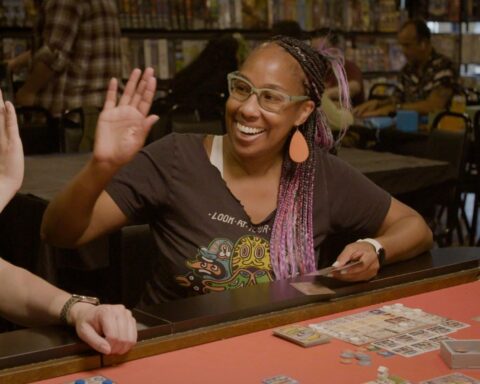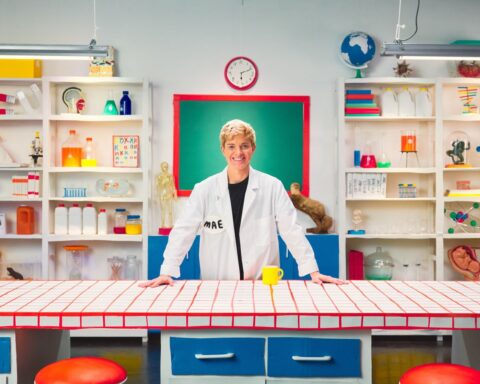EstDocs Film Festival programme director Kalli Paakspuu, who is interviewing Estonian animator Ülo Pikkov for POV, informs us that Pikkov will give an artist talk at 5:30 PM on Sunday, Nov. 5, 2017 at Tartu College (310 Bloor Street West (use entrance off Madison Avenue). Check Estdocs.com for more festival details.
K.P.: Kalli Paakspuu
Ü.P.: Ülo Pikkov
K.P.: As an animator, you regularly work on the script, editing, directing and design. What comes first: the script or the design? Can you tell us a little about how a project evolves for you and when you bring in other creative collaborators?
Ü.P.: The birth of every film is unique. There is no firm recipe to follow. Of course, it starts with some kind of idea and ambience, a feeling that I want to pass on with the film. The style and technique comes last. I search for a long time and at times have changed the whole process radically during the making of the film.
Empty Space trailer from Ülo Pikkov on Vimeo.
K.P.: You will be showing your 2016 EstDocs Jury award winning film Empty Space at your artist’s talk at Tartu College. In this film you animate Leonard Lina’s dollhouse created while he was in hiding during the Soviet terror of 1944-54 and which was loaned to you by the Tartu Toy Museum. How did you find out about this story?
Ü.P.: I first heard this story from a friend and it immediately felt like a film. I looked up Leonhard Lina’s daughter, Merike, and we had a lengthy interview. From that point things started to develop. The doll’s furniture left a strong impression with its focus and detail. At the same time it seemed as if it was an incomplete story that could only be brought to a proper finish as film, by taking Merike back in time to her childhood, bringing together her father’s dollhouse furniture and his aspirations.
K.P.: Tik Tak presents us with an animated mouse and an actor as a clock repairman in a workshop of mechanical clocks and parts. The mouse’s physicality is very fluid. It can climb up curtains, open doors and shut drawers with the physicality of an athlete. With the stop motion process, did you need to shoot some of the action several times? What was the most challenging sequence to film? How long did this film take to make?
Ü.P.: Tik Tak was completed in about nine months, of which the animation took under three months. Filming was done at a brisk pace, though the additional use of actors prevented filming any scene for more than two to three hours. Humans simply cannot stand or be in any related pose for a sustained period of time. The scenes with actors were perhaps the most challenging. The use of the mouse in the film was more of a symbol or metaphor, not an actual mouse. It represents an image from our memories. This memory constantly teases us and consumes us, though when we catch up to it, it brings our demise. The idiosyncrasy of such memories enriches our lives.
TIK-TAK from Ülo Pikkov on Vimeo.
K.P.: Tik Tak is a Faustian metaphor of humans creating the means for our own destruction. Your human clockmaker with his eyeglass is replaced by a figure created of mechanical clock parts. How many of these mechanical figures did you need to create for the stop motion? Can you explain more about your process and when you discovered this mechanical figure?
Ü.P.: Behind Tik Tak was the thought that we all live in different worlds, from dreams to reality. Similarly we all have a predetermined destiny and when our time ends, is there anything left? Humans perceive time as ever changing yet disappearing. Time is one of our everyday central concepts and measures. We can’t ‘see’ time, but can only perceive it. The purpose of animation films is to represent a metaphorical world, not how things appear, but what they mean to us.
K.P.: In both Empty Space and Tik Tak you combine a living person interacting with stop motion action. Your clockmaker’s movements look animated. Can you describe how you work with a living person in stop motion animation?
Ü.P.: One of my biggest passions is the use of actors in animation with the human becoming similar to the animation characters. Both Empty Space and Tik Tak are filmed frame-by-frame, similar to all other stop motion films, though I’ve used actors. There is nothing complicated about acting in animation films. People simply have to be patient and be able to sustain their poses without moving, it’s as simple as that!
K.P.: How does collaboration with other creatives work for you? Do many people work with you on a sequence as you direct? Can you describe your process in some detail?
Ü.P.: I am used to working with a small crew. Typically I have one operator and one animator. Depending upon the project, I may also have an artist and a few assistants who help build the characters and set decorations. I have always tried to keep the crew smaller, and thereby more motivated.
K.P.: You have been teaching animation for many years and have published a book, Animasophy – Theoretical Writings on the Animated Film developed from your teaching. What has been the main change in animation techniques from the years when you first started working in the form?
Ü.P.: Interestingly enough, I have observed over the past few years the return of the classical animation film. In particular, it is the handcrafted animation film that is once again very popular. Even the big film studios are beginning to offer full-length animation films, such as Fantastic Mr. Fox, Coraline, Boxtrolls, etc. Technology and special effects in film have become quite commonplace and are no longer as interesting. I think people want to see real handcrafted content and objects.
K.P.: Your film Body Memory has an abject beauty in the perfectly formed figures made of string. Yet it evokes a disturbing memory of human beings jammed together in cattle cars and sent to Siberia. What inspired you to tell this story? What came first?
Ü.P.: Body Memory depicts Estonia’s most tragic period of history, Stalin’s repressive state and deportations. At the same time the film maintains its abstract quality, where the story is told through symbolic associations. I wanted the film to depict the past not so much as a translation of history but as a subconscious experience (of the body’s memory). Body Memory in the given context can also be viewed as cultural memory, social memory or collective remembrance. An important departure in the creation of this film was to seek the physical experience. Even though I lack the connection to Stalin’s repressions and deportations, I chose to utilize the physical in making those connections and themes.
I wrote this for a 2011 synopsis of the film:
“The body remembers more than we can ever imagine, the body remembers its forefathers’ worries and pain. And so each body contains all the world’s stories. Our bodies carry our parents’ and grandparent’s stories, and their forefathers and so on.”
BODY MEMORY from Ülo Pikkov on Vimeo.
K.P.: It is interesting to note that the string that creates these animated figures also traps them like chains in their transport. Your animated figures are like puppets on strings. Can you tell us more about how you develop this relationship between a character and its environment? When do you begin collaborating with another creative?
Ü.P.: When creating the animation characters (dolls) for Body Memory, it was my intention that each character would have a connection to something personally valuable. Whether it was family, home or its homeland, as soon as the character was separated from its connection, it would physically fall apart. People have the ability to think in the abstract and give human qualities to the dolls, or it can be said that within all dolls there are human qualities—so as long as humans have the ability to believe in dolls. Body Memory to date has participated in nearly 170 international film festivals and it seems to be well received by audiences everywhere.
K.P.: What can you say about the history of Estonian animation? Was there a new consciousness in the art form when Estonia restored its Republic? Have you any comment on this?
Ü.P.: Although the first Estonian animation film Kutsu-Juku seiklusi (director Voldemar Päts, producer Aleksander Teppor and animator Elmar Jaanimägi) was completed in 1931, the continuity of animation ceased during the Second World War. After 1945, Estonian animation focused its support of the Soviet era and created “Eesti Joonisfilm” and “Nukufim” studios. During the Soviet era all films were controlled by the government and had to endure ideological censure. Post re-independence, as censorship ended, the Estonian animation visualization and creative traditions [but were freer in content]. I consider myself part of those who carry on the animation film tradition.
My Soviet Education from Ülo Pikkov on Vimeo.










